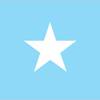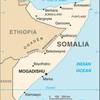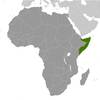Somalia [+]Compare [E]dit [H]istory
Aliases: Federal Republic of Somalia, Jamhuuriyadda Federaalkaa Soomaaliya, Somali Republic, SoomaaliyaObject «Somalia» was created due to
Add new object to «Somalia» or move existing objects here.
Object «Somalia» has attributes [Show empty attributes][Hide empty attributes]
| Attribute | Value |
|---|---|
| Geography | |
| Area | 637,657 km² |
| Continent | Africa |
| Land area | 627,337 km² |
| Water area | 10,320 km² |
| Land boundaries | 2,385 km |
| Border countries |
|
| Coastline | 3,025 km |
| Mean elevation | 410 m |
| Lowest point | 0 m |
| Highest point | 2,416 m |
| People | |
| Population | 11,757,124 |
| Official languages |
|
| Religion | Sunni Muslim |
| Government | |
| Long country name | Federal Republic of Somalia |
| Short country name | Somalia |
| Long local name | Jamhuuriyadda Federaalkaa Soomaaliya |
| Short local name | Soomaaliya |
| Former name |
|
| Government type | Federal parliamentary republic |
| Capital | Mogadishu |
| Economy | |
| GDP (PPP) | 20,440,000,000 USD |
| GDP (OER) | 7,052,000,000 USD |
| GDP (real growth rate) | 2.3 % |
| GDP - per capita (PPP) | Add |
| Gross national saving | Add |
| Labor force | 4,154,000 |
| Unemployment rate | Add |
| Population below poverty line | Add |
| Budget revenues | 145,300,000 USD |
| Budget expenditures | 151,100,000 USD |
| Military expenditures | Add |
| Taxes and other revenues | 2.1 % of GDP |
| Budget surplus or deficit | -0.1 % of GDP |
| Public debt | 76.7 % of GDP |
| Inflation rate | 1.5 % |
| Central bank discount rate | Add |
| Commercial bank prime lending rate | Add |
| Stock of narrow money | Add |
| Stock of broad money | Add |
| Stock of domestic credit | Add |
| Market value of publicly traded shares | Add |
| Current account balance | -464,000,000 USD |
| Exports | 819,000,000 USD |
| Imports | 94,430,000,000 USD |
| Reserves of foreign exchange and gold | 30,450,000 USD |
| External debt | 5,300,000,000 USD |
| National currency | Somali shillings |
| National currency (code) | SOS |
| National currency (symbol) | S |
| National currency rate to USD | 23 |
Britain withdrew from British Somaliland in 1960 to allow its protectorate to join with Italian Somaliland and form the new nation of Somalia. In 1969, a coup headed by Mohamed SIAD Barre ushered in an authoritarian socialist rule characterized by the persecution, jailing, and torture of political opponents and dissidents. After the regime's collapse early in 1991, Somalia descended into turmoil, factional fighting, and anarchy. In May 1991, northern clans declared an independent Republic of Somaliland that now includes the administrative regions of Awdal, Woqooyi Galbeed, Togdheer, Sanaag, and Sool. Although not recognized by any government, this entity has maintained a stable existence and continues efforts to establish a constitutional democracy, including holding municipal, parliamentary, and presidential elections. The regions of Bari, Nugaal, and northern Mudug comprise a neighboring semi-autonomous state of Puntland, which has been self-governing since 1998 but does not aim at independence; it has also made strides toward reconstructing a legitimate, representative government but has suffered some civil strife. Puntland disputes its border with Somaliland as it also claims the regions of Sool and Sanaag, and portions of Togdheer. Beginning in 1993, a two-year UN humanitarian effort (primarily in south-central Somalia) was able to alleviate famine conditions, but when the UN withdrew in 1995, having suffered significant casualties, order still had not been restored.In 2000, the Somalia National Peace Conference (SNPC) held in Djibouti resulted in the formation of an interim government, known as the Transitional National Government (TNG). When the TNG failed to establish adequate security or governing institutions, the Government of Kenya, under the auspices of the Intergovernmental Authority on Development (IGAD), led a subsequent peace process that concluded in October 2004 with the election of Abdullahi YUSUF Ahmed as President of a second interim government, known as the Transitional Federal Government (TFG) of the Somali Republic. The TFG included a 275-member parliamentary body, known as the Transitional Federal Parliament (TFP). President YUSUF resigned late in 2008 while UN-sponsored talks between the TFG and the opposition Alliance for the Re-Liberation of Somalia (ARS) were underway in Djibouti. In January 2009, following the creation of a TFG-ARS unity government, Ethiopian military forces, which had entered Somalia in December 2006 to support the TFG in the face of advances by the opposition Islamic Courts Union (ICU), withdrew from the country. The TFP was doubled in size to 550 seats with the addition of 200 ARS and 75 civil society members of parliament. The expanded parliament elected Sheikh SHARIF Sheikh Ahmed, the former ICU and ARS chairman as president in January 2009. The creation of the TFG was based on the Transitional Federal Charter (TFC), which outlined a five-year mandate leading to the establishment of a new Somali constitution and a transition to a representative government following national elections. In 2009, the TFP amended the TFC to extend TFG's mandate until 2011 and in 2011 Somali principals agreed to institute political transition by August 2012. The transition process ended in September 2012 when clan elders replaced the TFP by appointing 275 members to a new parliament who subsequently elected a new president.
Similar objects
Most often compared with
Everyone can something to edit or add.
There was one edit, no edits waiting approval. Last edited by wilkinson.michael(9581), Sep 16, 2019 (54 fields were changed)
Help · Contact us · Disclaimer · Contributors · Developers · Donate


